E-biking in the Alps, Switzerland. (Photo Satarupa Paul)
The icy wind howling through the mountains and glaciers threatened to blow me away, as I precariously stood clutching a fluttering Swiss flag — its bright red stark against the blinding white of the snow all around. Even as the wind whipped my face and made my eyes water, I grabbed the flag with both hands, trying to steady it enough for the white cross in the middle to be visible. By some sleight of hand, the thick fog that had enveloped us seemed to part and the sun shone through, allowing my shutter-happy friend the perfect light to click a few photos in quick succession. I had not only managed to climb to the "Top of Europe", but also capture the moment for eternity! The chill in my bones couldn’t keep me from feeling all warm with happiness inside.
I’ve been asked many times what takes me back to Switzerland over and over again, and my answers are always varied. Its stunning scenery, dreamy villages and medieval towns, its three distinct cultures (German, French, Italian), its amazing food drawn from the mix of cultural influences... This time though, I found myself in Switzerland for the one aspect that truly defines it — adventure! With the magnificent Swiss Alps, scores of beautiful lakes and rivers, and undulating meadows of the greenest green, the geography here lends itself effortlessly to a variety of adventures. Whether you’re a novice hiker or an expert base jumper, whether you’re looking for a leisurely boat ride or the thrill of climbing to one of the highest places in Europe, you can do it all here.
E-Biking through Terraced Vineyards in Lavaux
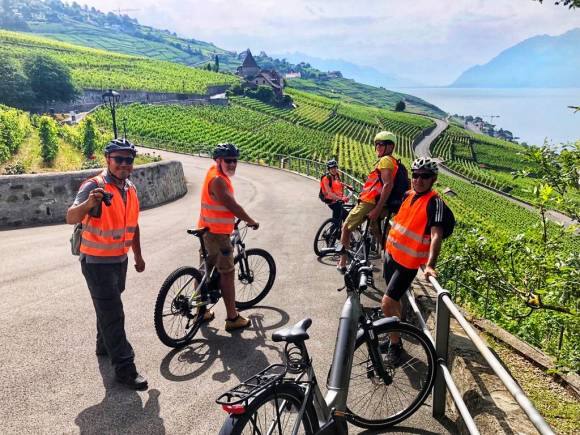 E-biking through the terraced vineyards in Lavaux. (Photo: Satarupa Paul)
E-biking through the terraced vineyards in Lavaux. (Photo: Satarupa Paul)
My Swiss adventure had begun on a mellow note, with one of the most picturesque e-bike tours through the terraced vineyards of Lavaux along Lake Geneva. Stretching for about 30 kms along the northern shore of the expansive Lake Geneva, one of the largest lakes in Western Europe, the vine terraces of Lavaux were designated a UNESCO World Heritage Site in 2007. Roughly 200 family-owned wineries are scattered in these vineyards, which go back to the 11th century when they were under the control of Benedictine and Cistercian monasteries. The wine produced is world class, yet not many know of or have tasted a Lavaux wine as they are mainly consumed locally.
Numerous hiking trails weave up and down through the vineyards, a few of which I had walked before on previous trips.
This time though, I chose to e-bike through the vineyards, with the cool breeze wafting up from Lake Geneva giving the exceptionally warm summer day a pleasant makeover. Ritual dictated that I stop by one of the wineries to enjoy a glass of crisp Chasselas — the dominant white variety, and a Pinot Noir or Gamay — the prevalent reds.
So, to round off a lovely morning of e-biking, I visited the cellar of Melanie Weber to give my biking-weary legs a rest and taste a variety of wines from her estate along with some traditional bar bites.
A waterfall hike & boat cruise near Interlaken
If you wish to get behind the scenes of a roaring waterfall—and feast your eyes on a spectacular scenery while at it—go for a hike up the Giessbach Falls, a half hour drive away from Interlaken. That is what I witnessed, as I hiked the 20-minute circular trail up the hillside and climbed the last stretch of ascent that took me right behind a curtain of water. Plunging down a total of 14 steps into the stunningly turquoise waters of Lake Brienz, the Giessbach Falls itself is a sight to behold. But manage to get behind it, as I did, and the sight can take your breath away! Beyond the curtain of water, your gaze is drawn to the green of the forested hills around, with the imposing castle of Grandhotel Giessbach sitting pretty against a backdrop of the unusually turquoise Lake Brienz.
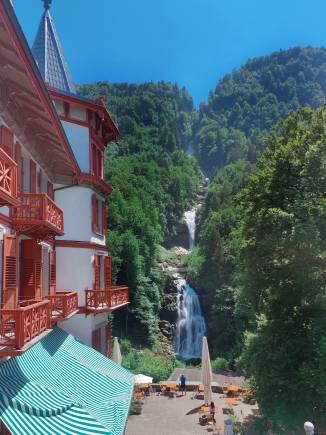 Giessbach Falls. (Photo: Satarupa Paul)
Giessbach Falls. (Photo: Satarupa Paul)
The hike up here is fairly easy on the legs, the views truly easy on the eyes. Refreshed by the spray of water on my face, I walked down to the Grandhotel for a delicious lunch of a secret traditional meatloaf recipe passed down generations. Many like to stroll down from here all the way to the jetty for a boat trip on the lake back to Interlaken. I however, rode down the historic funicular, whose design was a remarkable achievement for its time when it opened in 1879.
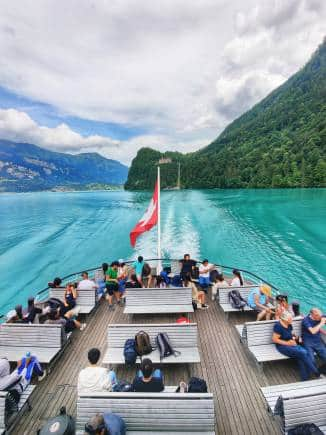 A boat cruise near Interlaken. (Photo: Satarupa Paul)
A boat cruise near Interlaken. (Photo: Satarupa Paul)
As I made myself comfortable on the open upper deck for the hour and half boat ride, the waterfall receded in the distance and I was surrounded by the meditative calm of Lake Brienz. A state of bliss, which was only broken — in a good way — by the excitement of docking at the fairytale villages along the lake’s shore, each more charming than the last!
Climbing to the ‘Top of Europe’ from Grindelwald
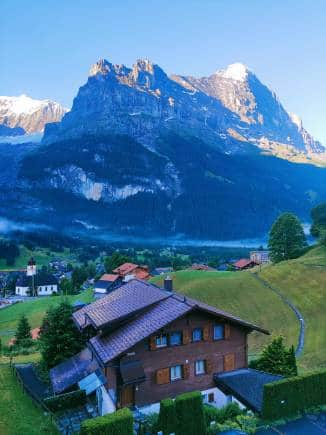 Jungfrau, one of the main summits of Bernese Alps. (Photo: Satarupa Paul)
Jungfrau, one of the main summits of Bernese Alps. (Photo: Satarupa Paul)
But, if you truly wish to experience what being in a fairytale feels like, come to Grindelwald. And if you wish to indulge in the most thrilling adventures that Switzerland has to offer, also come to Grindelwald. Tucked in the Bernese Alps amid rolling green meadows, the village of Grindelwald is surrounded by the mightiest of the Swiss Alps — including the Mönch, Eiger, Wetterhorn and Wellhorn, which are part of the UNESCO World Natural Heritage site of Jungfrau-Aletsch. Besides its incredible setting and picture-postcard looks, Grindelwald also serves as the gateway to some of the best Swiss adventures — from paragliding and skydiving above the Alps to terrifying canyon swings at the Grindelwald Glacier Canyon, as well as serious hiking with 300 km of walking trails around.
The most coveted though is the climb to Jungfraujoch — the largest glacier in the Alps that connects the two major 4,000ers of Jungfrau and Mönch, and is also home to the highest train station in Europe, popularly known as the "Top of Europe". There are two ways to go about it, the easiest is taking the new Eiger Express tricable car from Grindelwald Terminal to the Eigergletcher and continuing on the Jungfrau Railway. This barely takes 45 minutes, but being a seasoned hiker, I couldn’t pass up on the opportunity to take the longer, more arduous and more rewarding hiking route instead.
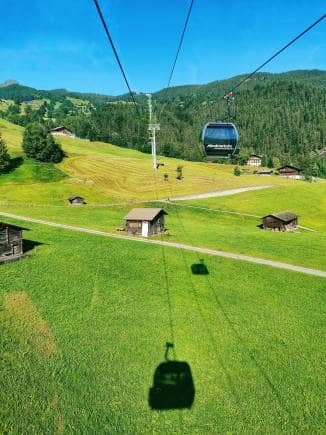 Eiger Express tricable car from Grindelwald Terminal to the Eigergletcher. (Photo: Satarupa Paul)
Eiger Express tricable car from Grindelwald Terminal to the Eigergletcher. (Photo: Satarupa Paul)
The Grindelwald-Männlichen gondola brought me to Männlichen (7,687 ft), from where I hiked what can only be considered as one of the most breathtaking routes in the Swiss Alps — up and down dirt tracks through green meadows carpeted with wild flowers in every colour imaginable, with the Eiger, Monch and Jungfrau looming majestically right in front of you! I arrived at the mountain pass of Kleine Scheidegg (6,762 ft) first, and from there via a short 3km part of the challenging 100 km-long Eiger Ultra Trail to the Eigergletcher, or Eiger Glacier. Only the most experienced adventurers choose to hike or ski the remaining distance to the Jungfraujoch. For the rest of us, there’s the Jungfraubahn train that takes you right to the ‘Top of Europe’ station (11,332 ft) in barely half hour.
A year-round snow-covered mountain destination, Jungfraujoch also houses the Sphinx Observatory, an Ice Palace, several shops and restaurants and the "Top of Europe" spot out in the vast, cold white, where my story had begun. It ends with me hurriedly sliding down the icy ground, back into the warm confines of the station building and to a hearty lunch with the Alps for company — an experience that can only be described as surreal!
QUICK FACTS
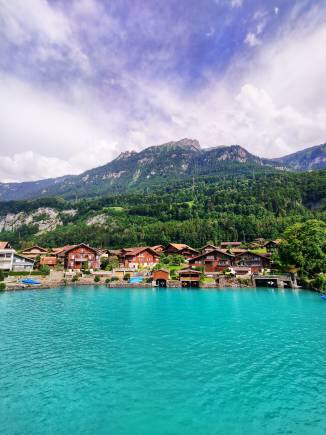 Interlaken. (Photo: Satarupa Paul)
Interlaken. (Photo: Satarupa Paul)- E-bikes for Lavaux tours can be rented from Lausanne, Vevey or Montreux; prices start from CHF 110 (Rs 9,700) and ideal duration is 4 hours.
- All boat rides including Lake Brienz are included unlimited with the Swiss Travel Pass, starting at CHF 230 (Rs 20,700).
- A round-trip tour from Grindelwald to Jungfraujoch aboard the Eiger Express cable car and Jungfrau Railways costs CHF 144 (Rs 12,800).